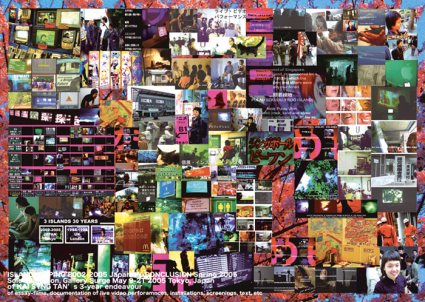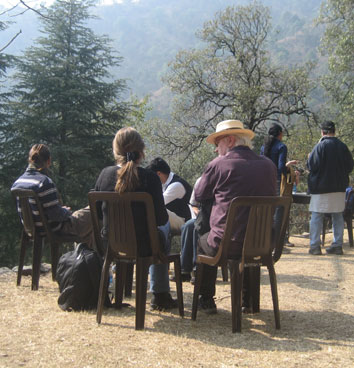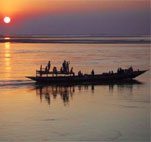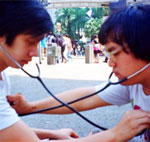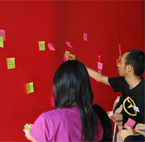singapore
I first came to Singapore in 2006, for the inauguration of
the Singapore Biennale. Having been given the impression from friends in Singapore
that there were very government regulations on the arts, with
low cultural provision, but a very high number of shopping
malls, an international festival for contemporary art seemed a
surprising event in this context.

singapore biennale

The inaugural Singapore Biennale was held in 2006, directed by
Nanjo Fumio of Mori Art Museum, and centred around the theme of
belief (which was widely interpreted). It opened to the fanfare of
the IMF World Bank Meeting, with obvious political and economic
motivations for such a contemporary art event. Many even questioned
if it was correct to call it a Biennale as they suspected there
would not be a second event. However this has been proved wrong and
the Biennale has been held again in 2008. At a time when the globe
seemed quite saturated with Biennales and Triennales, what did
Singapore feel it had to contribute in the form of a contemporary
arts festival? What made the Singapore Biennale different from any
other Biennale. The answer seemed to be because it was in
Singapore...

The Singapore Biennale was promoted as an international festival for local people, and it was claimed that locals were the main target audience of the program. With many such events the target is actually an international audience which can bring new attention to the region, increase tourism and support the economy. Often local people find little representation in these events and can not connect with the contents. However speaking to local artists and general audiences, people were glad of an opportunity to experience contemporary art on such a scale.
The Biennale did have a big impact on the city, with high visibility and opened up spaces not normally accessible to the public. For example a former army base, Tanglin Camp was renovated into an extensive exhibition area, and the law courts of the city hall were also opened up to present many engaging works. A key feature of the first biennale was the use of religious sites to present part of its program, these included mosques, Hindu temples, catholic and protestant churches, synagogues and Buddhist temples. This encouraged a new openness and movement between the religious institutions, allowing key insights for those outside of its membership and promoting cultural and religious tolerance.
p-10 / post museum

p-10 is an independent curatorial team consisting of Jennifer Teo, Woon Tien Wei, Cheong Kah Kit, Lee Sze-Chin and Lim Kok Boon. They have made Singapore their base since 2004 and have since been driving innovation in the arts creating a vital hub for artists and the arts community. They are committed to working with the local community and the local environment, responding to the specific conditions found here, while introducing new practices and perspectives from beyond Singapore. They moved to a new space in 2007 and established 'Post Museum' as an independent cultural space, consisting of an exhibition space, artist studios, meeting space and a vegetarian restaurant. Having moved to a new area in Singapore they are actively engaging with local people living in the neighbourhood and
films, workshops, symposia, performance, exhibitions, meeting place for many artists
p-10's main focus is on the development of artwork and the areas surrounding the practice of art. Our specific areas of interest include networking, dialogue and interaction between artists, art practitioners and audiences.
examine contemporary life, promote the arts and connect people.
tien wei woon

Tien is an artist and curator, and a founding member of p-10. In his artist practice he has demonstrated an interest in physical computing, attempting to make the internet and new media more tangible. He has been a member of net art collective tsunamii.net who have been challenging networked practices, investigating the relationship between physical space and cyberspace. They aim to shed light on the structures of the internet and how these might be manipulated, while encouraging discussion and debate on the impact of new media technology on wider society.
A well known project which he realized in collaboration with tsunamii.net is Virtual Marathon, in which internet users can compete against each other to 'run' through server spaces by typing two keys on a key board. This competition can take place between anyone around the world with an internet connection.
Tien is also a member of Danger Museum a collaboration with Øyvind Renberg and Miho Shimizu, an international mobile/virtual museum project realizing nomadic events in various locales and through the internet.
astrid almkhlaafy

astrid almkhlaafy is currently assistant professor at nanyang technological university department of art design and media. She has pursued her art and design practice internationally spending much time in Australia, UK and Japan. She has a strong interest in typography and graphic design history and has investigated these in particular relation to live arts, photography and book making. Many of her projects combine all of these elements in an attempt to immerse the audience in an experience of close communication. She historically locates this practice in line with the activities of the Futurists, Dadaists, Constructivists, Bauhaus and Black Mountain College in which new performance and improvisational experiments were also accompanied by a realization of new graphic and typographic works.
Her current major project involves research in China, Cambodia and
Indonesia in an investigation of sacred sites, temples and
mountains, examining the process of pilgrimage and methodologies of
performing and delineating such actions. One of the elements of this
project involves using gps traces to virtually cover a space in red,
her movements marked in digital spaces by a trailing red line, which
she manipulates to encircle mountains and religious spaces. In this
project she pursues the juxtaposition of the concrete, immovable
physical phenomenon of a mountain or an immense stone structure such
as Borobadour with the transitory impermanence of the human presence
and human experience. In this work she employs digital technologies
in a form of ritual performance for communication.
tan kai syng
Tan Kai Syng is a prolific video artist who has been investigating notions of postcolonialism and examining oral histories in a challenge to historical truth and grand narratives, reconstructing subjective history through personal memories. She has exhibited widely internationally and has spent much time researching in the UK and Japan. A major project has been 'Island Hopping' produced in Japan/Singapore between 2002-2005 which examines Japan's colonial past and aggression upon many countries in Asia, including occupation of Singapore. This project has many facets and presented in various forms, but includes a video series of first-hand documentary and archive footage of the continuing political conflict stemming from the war, pointing towards what is left unsaid, the burden of war responsibility and experiences of those who lived under occupation.
In her own words:
Through images, sound and artefacts collected during my travels in the islands of Japan and Singapore, the research-in-progress attempts to build up archipelagos of new meanings, and challenge existing boundaries. Theatres of conflict are deliberately generated: the personal clashes with the collective, meaning with noise, victim with victor, the universal with the essential. The artist — as well as the audience — navigates, negotiates and islandhops in between the cracks and crevices. In a narrative block in the ‘opus’ entitled A Plethora of Histories, the notion of an absolute history is problematised. The work juxtaposes disparate perspectives of the hitherto controversial Pacific War, such as an interview with a relative recollecting his experience of the traumatic Japanese Occupation in Singapore, and clips of my visit to the contentious Yasukuni war shrine shot with a hidden camera. No single narrative is foregrounded; all voices coexist in a cacophony.
syntfarm

Syntfarm is a collaboration between artists Andreas Schlegel and
Vladimir Todorovic. They began in 2007 to investigate the relation
between digital systems and ecosystems, based on a modular process
of interconnectivity in which they examine the various forms and
states of nature and how this may be applied in the evolution of
digital an synthetic forms.
'Each module in the ecosystem, the so called farm, questions and reinvents our usage, interactions, relations, and reinventions of the present technologies and our surroundings on socio-political-environmentalist contexts. '
Their projects have included detailed studies of natural areas and the utilization of technology to map data of organic and environmental processes which can then be applied in the evolution of the technological form itself. The outputs of this process have included performances, installations, rapid prototyping, video and sound responses.
rizman putra / kytv

“My belief is that art should transcend all boundaries and genres. This is what my performances and creations are about. My ultimate goal is to imbibe all cultures around me and produce an amalgamation of that product. The consumption of the Arts should be brought to the masses. One day all Art forms will be accessible to the man on the street.” - Rizman Putra
Rizman Putra is a highly energetic artist who is involved in many individual and collaborative projects. He has a range of lively and risqué persona which he often refers to in various performative based projects. One of these persona is Manic Jango, whom Putra describes as 'a lame superhero who can't save himself but has the desire to save the world..'. He works across genres combining performance, music, photography, video and digital media in projects which often explore stereotypes and alter-egos.
He is one of the founding members of the multi-disciplinary art group KYTV (Kill Your Television) formed in early 2002 with Aaron Kao and Jeremy Sharma to push the boundaries between various art forms, such as visual arts, installations, writing, movement, music/sound, and multimedia, 'hoping to create an integrative inter-disciplinary form of performance'. One example of their projects is Pop Station, which toured to London and Yogyakarta, an interactive experience in which the audience members are asked to take one their rock star alter-ego in a costume donning form of karaoke, in which participants can create their own music video.

substation

Singapore's first independent contemporary art space was established in 1990 with a vision to promote contemporary arts in Singapore providing a space for local and international practitioners to present their works, while also providing resources for local residents and communities to learn more about the arts and widen participation. This multi functional center provides a theatre/performance space, gallery, dance studio, rehearsal space and learning rooms. Substation runs a wide and varied program ranging from theatre productions, experimental musical performance, contemporary art exhibitions and educational courses. They aim to bring together diverse artists and audiences in an exchange of disciplines and perspective which will widen practices and understanding in the arts.
worms

Plastique Kinetic Worms has sadly disbanded since my first visit to Singapore, but in 2006 it appeared to be a very active space hosting exhibitions, live events, performance and an artist in residency program.
theatre works

Theatreworks is an innovative organization which has greatly promoted collaboration and exchange in the South East and wider Asian region. It is a dynamic theatre company which aims to bring together practitioners from many different disciplines including literature, performance, dance, visual arts, film and new media and open new dialogues between them while also engaging in a consideration of social-political issues facing various communities.
Its base is 72-13 which functions as a performance centre promoting collaborations, research, networking, dialogues between practitioners and publics. This is also host now to SCAN : Singapore Creative Arts Nucleus, which aims to raise opportunities for young emerging practitioners.
lasalle sia college of art

Singapore's leading art and design university also hosts a number of contemporary art spaces, which present local and international exhibitions.





